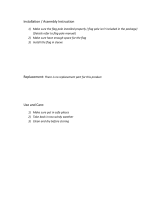
6
CroozerCargo19-ENG-1-19
Safety Guidelines
Riding downhill
Always reduce your speed when riding downhill. Riding at
excessive speeds could cause the trailer to skid, which can
result in accidents with serious injury or death.
Riding over kerbs or uneven surfaces
Riding over a kerb or other obstacle with only one wheel
of the Cargo Trailer could cause the Croozer to tip over,
resulting in accidents with serious injury or death. Empty
trailers are especially susceptible to tipping. Therefore, if
you have to ride over a kerb or similar obstacle, always
use extreme caution and ride at very low speeds. Never
use the Croozer Cargo on stairs or escalators.
Being visible to others
Never use your Croozer as a Cargo Trailer in road trafc
without its safety ag mounted. The safety ag makes it
easier for other road-users to see you.
If you plan to use the Croozer as a Cargo Trailer at night,
dusk or dawn – or when visibility is in any way reduced –
the trailer must be equipped with a fully functional light-
ing system. Be sure to familiarise yourself with the legal
requirements of the country or region where you plan to
use the Croozer.
Carrying cargo
Be sure to properly secure all cargo in the trailer to prevent
it from sliding or shifting, which could impair your riding
safety. Never transport objects that are too large to t com-
pletely into the cargo area of the trailer. Never attach car-
go, such as bags or panniers, to the outside of the Cargo
Trailer. Cargo attached to the outside of the Croozer Cargo
can drastically affect its handling and stability, potentially
resulting in accidents with serious injury or death. You can
carry smaller objects in the pocket inside the Cargo Trailer.
The Croozer Cargo as a Handcart
(accessory)
The Croozer Cargo with the Handcart Kit (accessory) is
not approved for jogging or skating. Pulling the Handcart
faster than a walking pace is not permitted.
Usage, storage and transport
Never transport the Croozer Cargo – even when folded –
on the roof of a motor vehicle, as this could damage the
fabric body.
Never use or store the Croozer Cargo at temperatures
below -20°C (-4°F).
Assembly, maintenance and repair
Purchased condition and initial assembly
If you have purchased the Croozer Cargo from a shop,
the dealer should have installed the axle hitch to the tow-
ing bicycle. If you ordered your Croozer from an online
or mail-order catalogue, we recommend having the initial
assembly performed by a professional bicycle mechanic.
Furthermore, dealers are required to provide their custom-
ers with all important information on the use of the Croozer
Cargo. To nd an authorised dealer in your area, visit the
Croozer website at www.croozer.com.
Technical condition
Never use the Croozer Cargo if it is not in perfect working
order. The Croozer Cargo must be periodically inspected
for damage and/or wear to the wheels, hitch arm, frame,
fabric body, security pins and axle hitch. If any of these
parts are found to be damaged, the Croozer Cargo may
not be used until the damage has been properly repaired,
ideally by a professional bicycle mechanic.
It is critical that all maintenance work specied in this
manual be performed in the specied intervals.
Using the Croozer when it is not in perfect working order
can result in accidents with serious injury or death.
Proper installation and repair
The Croozer Cargo must be properly assembled to profes-
sional standards. Follow the instructions for the correct
installation of the axle hitch, hitch arm and Handcart Kit
(accessory). When in doubt, contact your Croozer dealer.
All repairs must be carried out to professional standards
using only original Croozer parts, ideally by a professional
bicycle mechanic. Incorrect installation or repair work could
result in accidents with serious injury or death.
Suitable accessories and original spare parts
Only use accessories and original spare parts that have
been recommended and approved by Croozer GmbH.
These are the only components that can be used safely
with the Croozer Cargo. When in doubt, consult a Croozer
dealer. The use of non-approved accessories or incompat-
ible spare parts could result in accidents with serious injury
or death. Croozer GmbH will not be liable for any damage
resulting from the use of non-approved accessories or
incompatible spare parts.
Changes and modications
For safety reasons, no modications or changes can be
made to the Croozer Cargo.
Do not install additional components, such as luggage
racks etc. Do not install electric drive systems. Making
modications or changes to your Croozer can result in ac-
cidents with serious injury or death. Furthermore, changes
or modications to the vehicle will void any warranty
claims. Croozer GmbH will not be liable for any damage
resulting from changes or modications that have been
made to the Croozer.


































